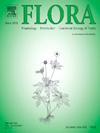寄生植物同域种族中宿主驱动的表型和表观分化
IF 1.7
4区 生物学
Q3 ECOLOGY
引用次数: 0
摘要
寄主特异性是影响寄生生物生态学和进化多样性的一个关键因素。众所周知,寄主特异性和地理隔离会导致寄生植物异地种族的遗传分化。然而,在同域中如何出现分化在很大程度上仍是未知数。我们研究了一种具有高度寄主专一性的极端内生性全寄生虫--Cytinus hypocistis(Cytinaceae)的三个同域遗传品系之间的表型和表型分化以及潜在的生殖隔离。我们比较了六个共生种群中寄生于 Cistus ladanifer、C. salviifolius 和 Halimium halimifolium(肉苁蓉科)的三个种族在开花物候学、花产量、花期、花回报和形态方面的时空变化,并进行了种族间授粉。我们发现,宿主定义的基因种族在多个表型和表观方面存在显著差异--由于植物的隐蔽形态,这一现象以前曾被忽视。寄生在 H. halimifolium 上的种族开花更早,花朵更艳丽,花朵更长,花粉产量和花蜜浓度更高;寄生在 C. salviifolius 上的种族开花更晚,花朵艳丽程度明显降低,花朵更小,花粉产量和花蜜浓度更高;寄生在 C. ladanifer 上的种族具有中间特征。遗传种族之间可以相互交配,但由于基因流动受限和寄主驱动的选择压力,它们之间可能仍然存在差异。总之,我们的数据揭示了一个罕见的同域分化进化案例:表面上形态相似的共生寄生虫种族可能在遗传、表型和表观上截然不同。这一迄今为止尚未报道的寄主驱动的同域多样化实例,对如何将物种概念应用于隐蔽的寄生植物种族提出了挑战。本文章由计算机程序翻译,如有差异,请以英文原文为准。
Host-driven phenotypic and phenological differentiation in sympatric races of a parasitic plant
Host specificity is a key factor influencing the ecology and evolutionary diversification of parasitic organisms. Host specialisation and geographic isolation are known to lead to the genetic differentiation of allopatric races in parasitic plants. However, how divergence can co-occur in sympatry remains largely unknown. We investigated phenological and phenotypic differentiation and potential reproductive isolation among three sympatric genetic races of Cytinus hypocistis (Cytinaceae) - an extreme endophytic holoparasite with a high degree of host specialisation. We compared spatio-temporal variations in flowering phenology, flower production, floral longevity, floral rewards, and morphology, and conducted inter-race pollinations among three races parasitising Cistus ladanifer, C. salviifolius, and Halimium halimifolium (Cistaceae) in six co-occurring populations. We found that host-defined genetic races differed significantly across multiple phenotypic and phenological aspects – a phenomenon previously overlooked due to the plants’ cryptic morphology. The race parasitising H. halimifolium showed earlier blooming, higher floral display, longer flowers, and higher pollen production and nectar concentration; the race on C. salviifolius showed later flowering, significantly lower floral display and smaller flowers with lower floral rewards; the race on C. ladanifer had intermediate characteristics. Genetic races were interfertile yet may remain differentiated by restricted gene flow and host-driven selection pressures. Together, our data point to a rare case of sympatric divergent evolution hiding in plain sight: apparently morphologically similar co-occurring parasite races can be genetically, phenotypically, and phenologically distinct. This hitherto unreported example of host-driven sympatric diversification challenges how species concepts are applied to cryptic parasitic plant races.
求助全文
通过发布文献求助,成功后即可免费获取论文全文。
去求助
来源期刊

Flora
生物-植物科学
CiteScore
3.30
自引率
10.50%
发文量
130
审稿时长
54 days
期刊介绍:
FLORA publishes original contributions and review articles on plant structure (morphology and anatomy), plant distribution (incl. phylogeography) and plant functional ecology (ecophysiology, population ecology and population genetics, organismic interactions, community ecology, ecosystem ecology). Manuscripts (both original and review articles) on a single topic can be compiled in Special Issues, for which suggestions are welcome.
FLORA, the scientific botanical journal with the longest uninterrupted publication sequence (since 1818), considers manuscripts in the above areas which appeal a broad scientific and international readership. Manuscripts focused on floristics and vegetation science will only be considered if they exceed the pure descriptive approach and have relevance for interpreting plant morphology, distribution or ecology. Manuscripts whose content is restricted to purely systematic and nomenclature matters, to geobotanical aspects of only local interest, to pure applications in agri-, horti- or silviculture and pharmacology, and experimental studies dealing exclusively with investigations at the cellular and subcellular level will not be accepted. Manuscripts dealing with comparative and evolutionary aspects of morphology, anatomy and development are welcome.
 求助内容:
求助内容: 应助结果提醒方式:
应助结果提醒方式:


